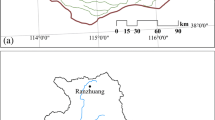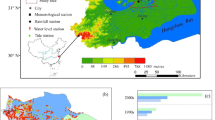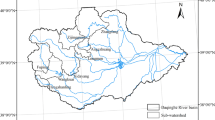Abstract
Traditionally, flood frequency analysis under the assumption of stationarity has been a cornerstone and there is mature technology applied in practice. However, recent evidences of the impact of climate variability and anthropogenic factors have thrown into question the applicability of stationary hypothesis. In this study, Kendall’s tau and Spearman’s rho correlation test were adopted to detect the relationship between climate indices (PDO, NAO, AO, NPO and ENSO) and annual flood peak data. The test results showed that NPO and Niño3 had significant correlations with the flood peak which could prove the climate cause of non-stationarity. Niño3 is used herein to describe ENSO. We also proposed a check dam index (CDIp) to represent the effect of human activities that caused nonstationarity on flood. The CDIp was based on the estimated storage capacity and drainage area of large number of check dams and small hydraulic structures. A framework for nonstationary flood frequency analysis was developed through Generalized Additive Models in Location, Scale and Shape (GAMLSS), and two models based on GAMLSS were applied to the annual flood peak. The model results that incorporated climate indices (NPO and Niño3) and CDIp as covariates in the parameters of the selected distribution exhibited an undulate behavior, which could better describe nonstationarity than the model with only time dependence. For a reservoir index (RI) proposed by López and Francés (2013) which is similar to CDIp, we established two contrast models and the result revealed that CDIp is superior to RI. These results highlight the necessity of flood frequency analysis under nonstationary conditions, and alternative definitions of return period should be adapted.











Similar content being viewed by others
References
Akaike H (1974) A new look at the statistical model identification. IEEE Trans Autom Control 19:716–723
Boutselis P, Ringrose TJ (2013) GAMLSS and networks in combat simulation metamodelling: a case study. Expert Syst Applic 40:6087–6093
Cole TJ, Green PJ (1992) Smoothing reference centile curves: the LMS method and penalized likelihood. Stat Med 11:1305–1319
Cong N, Feng P (2014) Revision on reservoir inflow design flood under the variation impact of underlying surface. South-North Wat Transf Wat Sci Technol 12:6–10
Cooley D (2013) Return periods and return levels under climate change. In: AghaKouchak A, Easterling D, Hsu K, Sorooshian S (eds) Extremes in a changing climate, water science and technology library, vol 65. Springer, Netherlands, pp 97–114
Cunderlik JM, Burn DH (2003) Non-stationary pooled flood frequency analysis. J Hydrol 276:210–223
El Aldouni S, Ouarda T, Zhang X, et al. (2007) Generalized maximum likelihood estimators for the nonstationary generalized extreme value model. Wat Res Res. 43, doi: 10.1029/2005WR004545
Filliben JJ (1975) The probability plot correlation coefficient test for normality. Technometrics 17:111–117
Franks SW, Kuczera G. (2002) Flood frequency analysis: evidence and implications of secular climate variability, New South Wales. Water Res Res. 38, doi: 10.1029/2001WR000232
Gutierrez F, Dracup JA (2001) An analysis of the feasibility of long-range streamflow forecasting for Colombia using El Niño-Southern Oscillation indicators. J Hydrol 246:181–196
Haguma D, Leconte R, Cote P et al (2014) Optimal hydropower generation under climate change conditions for a northern water resources system. Water Resour Manag 28:4631–4644
Kashelikar AS, Griffis VW. (2008) Forecasting flood risk with Bulletin 17B LP3 model and climate variability. Paper presented at World Water and Environmental Resources Congress, American Society of Civ1 Engineers, edited by Babcock R W and Walton R, Honolulu, Hawaii
Kiem AS, Franks SW, Kuczera G. (2003) Multi-decadal variability of flood risk. Geophys Res Lett. 30, doi: 10.1029/2002GL015992
Li JZ, Liu XY, Chen FL (2014) Evaluation of nonstationarity in annual maximum flood series and the associations with large-scale climate patterns and human activities. Water Resour Manag. doi:10.1007/s11269-014-0900-z
Liang W, Bai D, Jin Z et al (2015) A study on the streamflow change and its relationship with cliamte change and ecological restoration measures in a sediment concentrated region in the loess plateau. Chin Wat Res Manag 29:4045–4060
López J, Francés F (2013) Non-stationary flood frequency analysis in continental Spanish rivers, using climate and reservoir indices as external covariates. Hydrol Earth Syst Sci 17:3189–3203
Luo JW, Chen LN, Liu H (2013) Distribution characteristics of stock market liquidity. Phys A: Stat Mech Applic 382:6004–6014
Milly PCD, Betancourt J, Falkenmark M et al (2008) Stationarity is dead: whither water management? Science 319:573–574
Mourato S, Moreira M, Corte RJ (2015) Water resources impact assessment under climate change scenarios in Mediterranean watersheds. Water Resour Manag 29:2377–2391
NRC (1998) Decade to century scale climate variability and change: a science strategy. panel on climate variability on decade to century time scales. National Academy Press, Washington, DC
Nune R, George BA, Teluguntla P et al (2014) Relating trends in streamflow to anthropogenic influences: a case study of Himayat Sagar catchment. Ind Wat Res Manag 28:1579–1595
Olsen JR, Lambert JH, Haimes YY (1998) Risk of extreme events under nonstationary conditions. Risk Anal 18:497–510
Poff NL, Bledsoe BP, Cuhaciyan CO (2006) Hydrologic variation with land use across the contiguous United States: geomorphic and ecological consequences for stream ecosystems. Geomorphology 79:264–285
Rigby RA, Stasinopoulos DM (1996a) A semi-parametric additive model for variance heterogeneity. Stat Comput 6:57–65
Rigby RA, Stasinopoulos DM. (1996b) Mean and dispersion additive models. Statistic Theor Comput Aspect Smooth. pp. 215–230
Rigby RA, Stasinopoulos DM (2005) Generalized additive models for location, scale and shape. J R Stat Soc: Ser C: Appl Stat 54:507–554
Salas J, Obeysekera J (2014) Revisiting the concepts of return period and risk for nonstationary hydrologic extreme events. J Hydrol Eng 19:554–568
Serinaldi F (2015) Dismissing return periods! Stoch Env Res Risk A 29:1179–1189
Serinaldi F, Kilsby CG (2012) A modular class of multisite monthly rainfall generators for water resource management and impact studies. J Hydrol 464–465:528–540
Shi P, Ma XX, Hou YB et al (2013) Effects of land-use and climate change on hydrological processes in the upstream of Huai river. Chin Wat Res Manag 27:1263–1278
Stasinopoulos DM, Rigby RA (2007) Generalized additive models for location scale and shape (GAMLSS) in R. J Stat Softw 23:1–46
Stedinger JR, Griffis VW (2011) Getting from here to where? flood frequency analysis and climate1. JAWRA J Am Wat Res Assoc 47:506–513
Strupczewski W, Singh V, Feluch W (2001) Non-stationary approach to at-site flood frequency modeling I. maximum likelihood estimation. J Hydrol 248:123–142
Vasiliades L, Galiatsatou P, Loukas A (2015) Nonstationary frequency analysis of annual maximum rainfall using climate covariates. Water Resour Manag 29:339–358
Villarini G, Smith JA, Serinaldi F et al (2009) Flood frequency analysis for nonstationary annual peak records in an urban drainage basin. Adv Water Resour 32:1255–1266
Villarini G, Smith JA, Napolitano F (2010) Nonstationary modeling of a long record of rainfall and temperature over Rome. Adv Water Resour 33:1256–1267
Villarini G, Smith JA, Serinaldi F et al (2012) Analyses of extreme flooding in Austria over the period 1951–2006. Int J Climatol 32:1178–1192
Viola MR, Mello CR, Norton LD (2014) Impacts of land-use changes on the hydrology of the Grande river basin headwaters, Southeastern Brazil. Water Res Manag 28:4537–4550
Wahl S, Fenske N, Zeilinger S et al (2014) On the potential of models for location and scale for genome-wide DNA methylation data. BMC Bioinform 15:1471–2105
Zeng H, Feng P, Li X (2014) Reservoir flood routing considering the non-stationarity of flood series in north China. Water Resour Manag 28:4273–4287
Zhang AJ, Zhang C, Fu GB et al (2012) Assessments of impacts of climate and human activities on runoff with SWAT for the Huifa River basin, northeast China. Water Resour Manag 26:2199–2217
Zhang C, Christine AS, Joshua DW et al (2013) Impact of human activities on stream flow in the Biliu River basin. Chin Hydrol Process 27:2509–2523
Zhang AJ, Zhang C, Chu JG et al (2015) Human-induced runoff change in northeast China. J Hydrol Eng. doi:10.1061/(ASCE)HE.1943-5584.0001078
Acknowledgments
This work was supported by National Natural Science Foundation of China (No. 51209157). We are also grateful to Hydrology and Water Resource Survey Bureau of Hebei Province for providing the hydrometeorological data.
Author information
Authors and Affiliations
Corresponding author
Rights and permissions
About this article
Cite this article
Li, J., Tan, S. Nonstationary Flood Frequency Analysis for Annual Flood Peak Series, Adopting Climate Indices and Check Dam Index as Covariates. Water Resour Manage 29, 5533–5550 (2015). https://doi.org/10.1007/s11269-015-1133-5
Received:
Accepted:
Published:
Issue Date:
DOI: https://doi.org/10.1007/s11269-015-1133-5




